Magneto: Not A Hero #1 (Marvel Comics, $2.99)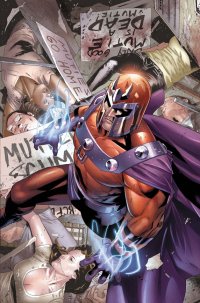
By Devon Sanders
There are a few personal truths I go by when reading something by an artist turned writer:
An 80’s/90’s Frank Miller type/thing only happens once in a lifetime and the publisher wants you to pay for the experience of watching the writer/artist’s learning curve. Usually, the results ain’t pretty as half the Batman line exhibits.
Now, with the X-Men franchise, I don’t know if one specifically looks there for great stories to be told simply as much as looking for X-Men stories to be told. Meaning, nowadays, if one wants simple conflict and pictures of Wolverine on the page, one need look no further any X-title. Or two Avengers titles.
Add to that the expanding X-Men roster and the lack of proper space in which to flesh out characters and “BAM,” why not do a mini-series? And what better way to test a character’s legs, expand on an idea and someone’s writing ability?
That said:
Magneto: Not A Hero #1, anyone?
A man garbed in purple and red simply walks into an anti-mutant rally and kills everyone in sight. Captain America and Iron Man call on The X-Men’s Cyclops for an explanation and for retribution, if necessary. The thing is that when this all went down, Magneto was five states away with The X-Men. With The President of The United States calling for Magneto’s arrest, The Master of Magnetism has mere hours to clear his name and calm an almost certain backlash against the mutant population.
Writer Skottie Young right out of the gate shows great chops, honestly surprising me with his command of dialogue and set-up. (Loved his Cap/Iron Man interaction, by the way.) Young’s premise is simple one and the payoff could result in typical X-Men grandstanding but from what I’ve seen so far, subsequent issues will continue to be as entertaining as the first.
Artist Clay Mann has a simple, uncluttered style with his layouts reminding me of Mighty Thor’s Olivier Coipiel in certain places. Mann’s work is solid and is a fine choice for this story.
Magneto: Not A Hero #1 surprised me in its simplicity. It’s a surprisingly well-written, well-drawn Magneto comic that in the midst of the greater “Regenesis Saga,” actually does what it needs to do… it entertains.
Rating: 




Out of a Possible 5 Stars
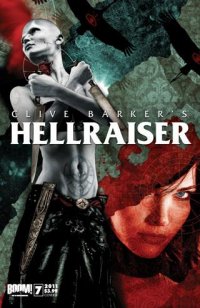 Hellraiser #7 (Boom! Studios, $3.99)
Hellraiser #7 (Boom! Studios, $3.99)
By Bart Bishop
Kirsty Cotton has made a deal with a devil, but it’s a devil she knows. Over the last six issues of Boom! Studios’ ongoing Hellraiser series she has been locked into a crash course with the titular character. Originally intending to destroy the Cenobite known as Pinhead once and for all, she now finds herself faced with an unthinkable possibility: replacing him. This is an intriguing possibility, certainly much richer than the last five(!) direct-to-video sequels in this nine part series. The problem is authors Christopher Monfette and Clive Barker proceed with the assumption that their audience is intricately familiar with not only the characters from the first two movies but the mythology as well. This isolates this text as subordinate to its predecessor rather than as an independent beast.
Here’s the official solicitation for this issue: “One of the greatest horror franchises of all time returns, now under the control of its original creator! Clive Barker has touched HELLRAISER only twice: once to write THE HELLBOUND HEART, and once more to write and direct the original HELLRAISER film. Now witness Barker’s long-awaited return to tell a new chapter in the series’ official continuity—a trajectory that will forever change the Cenobites…and Pinhead! He thought he knew his place in the void, but in this issue Pinhead discovers something that will shake HELLRAISER fans to their core.”
There’s an implication here that the series has gotten off track, not just these last five movies but all of the sequels. That’s a provocative assertion, as it attempts to invalidate the hard work of Tony Randel and Peter Atkins with the second through fourth movies. Which is arbitrary, anyway, because this series acknowledges the events of those movies (there’s even a subtle acknowledgment of the sixth movie, Hellseeker, in the first issue with Kirsty’s last marriage mentioned), and much of the story is predicated on the events of the second movie. So why play up Barker’s role? It certainly works as a bit of branding and marketing, as it’ll appeal to any fan that believes in the purity of the original author’s return.
I’ve long been a fan of the film series, even if it often leaves my soul feeling tainted, so is this series a worthy successor? It certainly tries. It’s paced well, introducing all the pieces of the narrative puzzle in measured doses. The first story arc, “Pursuit of the Flesh” was concerned with setting up Pinhead’s motivation to escape from Hell and Kirsty & the Harrowers attempting to destroy all of Lemarchand’s devices that serve as portals to Hell. So far this second story arc, “Requiem”, has Pinhead’s plan being executed, as he wants to be human again in order to achieve salvation and go to Heaven.
That’s an intriguing concept, but it’s hard to feel for Pinhead or Kirsty’s plight when they’re hardly developed as characters. There’s an over-reliance on knowledge of the first two movies, in which Pinhead was revealed as the former British officer Elliot Spencer and Kirsty was little more than a jealous daughter and girl-next-door type. Here intrigue is added as their roles reverse: Pinhead has shown mercy, whereas Kirsty’s consistently shown to have a dark side that links her in spirit to Pinhead, but there’s little explanation for that darkness. Her first experiences with the Lament Configuration were completely by accident and ended horribly, why would she be curious or seduced by promises she knows are false?
There’s not a hint of hedonist in the vanilla Kirsty. Her character is defined by her hatred for the Cenobites, her flaky commitment to fiancé Edgar (author of The Dream Sea & Story Tree, which sounds like a book I would’ve read in grad school), her ability to gather the Harrowers in a common cause, and the Machievallian lengths she’s willing to go to for revenge. Those are all plot devices, not characteristics. The Harrowers, as well, are defined by their titles: Marcus is a priest, Beth a call girl, and Alex a doctor and former facilitator (he used to give Lemarchand’s devices to people, but had a crisis of conscious). The entire first story arc is predicated upon the actions of several sullen people, and the second arc has Kirsty going to extreme lengths to save them, but why should I care?
Also, the rules of the Cenobites are inconsistent, both within this series and in comparison to the movies. In issue #2 when the “sub-surface circus” Cenobites are summoned from the Carousel, they declare, “You called, we came.” This is along the lines of the first two movies that had a strong sense of fair play to them, such as in the second movie when Pinhead announces, “It is not hands that call us, it is desire” in response to Channard’s trickery. This comic has the Cenobites acting without rhyme or reason: sometimes when the puzzle is solved they tear people to pieces, other times they steal their unborn fetuses and let the people go. I used to love the theme of personal responsibility inherent in the series, but now anyone nearby can get killed if Pinhead is flinging a chain around.
The first two movies also established that it was very hard, if not impossible, for most people to solve the puzzle box. Frank took weeks, and Channard couldn’t so he had to get Tiffany. This series, however, depicts people solving the puzzle almost instantly. Hellraiser III has a Kirsty cameo say something about how the box wants to be solved, but I thought “official continuity” was only sticking to the texts Barker has touched? It would be nice, as well, if the weapons of the Harrowers were explained in any way: there’s throwaway remarks about runes, glyphs and mysticism, but little reason why these methods and weapons make the Cenobites vulnerable. They certainly weren’t in the movies, and I only have a glimmer of memory of them being used in the old Marvel Epic series.
Speaking of Tiffany, the formally mute puzzle solver has been reduced to a killer sex kitten that refers to Kirsty as mother. This is all disconcerting (especially since the, as mentioned in-text, 25 years old Kirsty still looks 25), and not in the skincrawling way that Barker specializes in but in a bad screenwriting sort of way. How did Tiffany get to this point, and why did anyone think this was a preferable version to the mysterious lost girl of Hellbound?
How is issue #7 as a jumping on point? It’s the middle of the second story arc of this ongoing series, so it’s not overly friendly to new readers but there’s an attempt. There’s a solid recap on the credits page, and the through-line narrative is quite simple: Pinhead wants to escape Hell, Kirsty is attracted to it, and now she’s destroyed the box and sealed herself inside. The problem is those names mean little without knowledge of movies from over twenty years ago. The dialogue is ham-fisted at times, and like always the best lines go to Pinhead (“If angels dance on the heads of pins, how blessed might I be?”). It’s unfortunate that the villain of the piece is the only engaging character, but perhaps Barker wants us to root for him? Can there be sympathy for the devil? There’s a clever bit of meta-commentary as Pinhead argues with a fellow damned soul, who chides him, “Speak your request, antagonist! For you are not the hero of this tale!” He is, however, referred to as the “iconic killer” on the recap page, so there’s a feeling that this series has an initiative to get Pinhead right where he hasn’t been for a while. Considering Barker has been working on a novel titled The Scarlett Gospels for several years now, and has claimed that it lacks a publisher, one must wonder how much of that is being put into this series.
The cover by Tim Bradstreet, best known for his Punisher work, is striking but oversexualizes the Female Cenobite in such a way as to, unfortunately, misinterpret her character. Really, it misunderstands the themes of unconventional sensuality in the series, depicting a rather traditional pinup pose with a character that is decidedly not a covergirl. The interior art by Stephen Thompson and Janusz Ordon is bleak and atmospheric, but adds little in the way of characterization or expression. The inking and shadowing is so thick it’s hard to make out facial features, and the coloring is rather monochromatic at times (reminiscent of Daredevil’s Alex Maleev). Entire pages will be in differing shades of black, blue, or orange, which builds mood but creates a distance between audience and the protagonists. If the entire comic is otherworldly, what is the impact when the gateway to Hell is opened? There’s an effective opening scene of a lush, rural landscape in Kirsty’s fever dream, but that’s few and far between. Independent of the ink and coloring, the artists do a solid job of capturing photorealistic depictions of Ashley Lawrence as Kirsty Cotton and Doug Bradley as Pinhead, but as a result there’s a lack of movement. Everyone looks like mannequins. The creature designs, and Hell itself, are amazing (combining the best elements of the movies with a gonzo visualization of Dante’s Inferno) and the gore is respectfully nauseating, revealing the inner human form in all its bloody glory. What hits me, however, is the lack of necessity. The Pinhead of the movie had class and abided by a strict set of rules. Tearing apart a subway, like in issue #4, reeks of Hell on Earth Pinhead, wantonly causing destruction to play to the audience rather than to the plot.
I will admit I’m intrigued. Although this issue lacked much in forward momentum, the (unnamed?) Female Cenobite’s role was unexpected, and the hints at greater revelations about Pinhead’s machinations will bring me back next month. If Kirsty is a non-entity at the moment, she can only become more layered as she enters into the lion’s den. This was a mostly action-packed issue, with the first half set to a more ambient soundtrack as there’s little dialogue. Still, there is a feeling of a knot being tied as plot threads come together, and I’m always fascinated by mortal characters confronting higher powers. Kirsty entering into Leviathan to parley with Pinhead is akin to Truman speaking to Christof or Neo meeting the Architect and should prove fruitful, although it’s about the third time this series has teased these characters…talking.
Can’t they get a cup of coffee and hash this out already?
Rating: 




Out of a Possible 5 Stars
The Avenging Spider-Man (Marvel Comics, $3.99)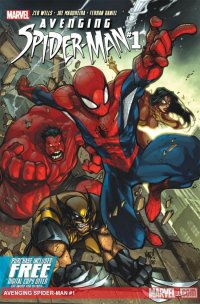
By Bart Bishop
Now that was fun! The Avenging Spider-Man starts off with a bang and promises non-stop thrills, if not a lot of substance. The first new ongoing Spider-Man comic since 2008 promises to serve as an ADD counterpart to the more Soap Operatic The Amazing Spider-Man. For several years, first with the “Brand New Day” initiative and then consecutive brandings, Amazing Spider-Man has had an alternating set of writers publishing three issues a month. This worked well for small, tight story arcs that translated into trade paperbacks, but for the casual reader it became overwhelming. So much Spider-Man, with little in the way of chronological organization, does not lead to easy access. Avenging Spider-Man shows a return to status quo for Marvel, as Spider-Man now has multiple ongoing series, and this will serve as a team-up comic with rotating guest-stars. It’s also the return of Joe (Mad)ueria to the 616 Marvel U (he was the artist on The Ultimates 3 a few years ago), and what a return!
First of all, what is Spider-Man to me? He’s a character that had run his course. The last decade of Peter Parker’s adventures have had an air of desperation to them. J. Michael Strazynski had a grasp on the character’s voice (I really liked him as a high school teacher, a concept that was never exploited), but the whole destiny spider was entirely ill-advised. Mark Millar’s Marvel Knights Spider-Man was the death knell of the modern, married Peter Parker, a treatise on why that direction lacked direction. Everything surrounding Civil War and its aftermath was painful to read. “Brand New Day” cleared the deck and offered up new possibilities, but proved rather uneventful and bland. None of the new supporting characters or villains have stood out, but at least the character had been modernized and made approachable again. With the simplicity inherent in the character, however, there is a sense of freedom: Why not give him a new, temporary costume ever few years? Or put him on a new superteam? New job, new boss, none of these things change the form and function of the character.
Acessible is the key word, and Avenging Spider-Man delivers. The issue lives up to the title, as Peter Parker does not make an appearance and Spider-Man is fully immersed in the world of the Avengers. A natural, easy flowing narration brings the audience up to speed on the balancing act Spidey maintains as both solo superhero, Avenger, and normal young man, but the details are minimal. He has “girl problems, a full-time job, membership on any super-team that will have you…including two (two!) separate teams of Avengers. Spider-Man, where do you find the time?” This is a knowing attempt at negotiating fan concerns with over-saturation. It’s appropriate that Wolverine is present at the beginning of this issue, as he is a character that also manages to show up in every nook and cranny of the Marvel U. I like Wolverine and Spidey as members of the Avengers, and the question of time has never bothered me. Why do I need to know what days of the week he spends with the Future Foundation and what days he’s fighting Doc Ock? Story matters, and if I’m entertained and tantalized then continuity be damned.
Zeb Wells, who had previously worked with showrunner Dan Slott over at Amazing Spider-Man, has a firm grasp on the wallcrawler’s personality and humor. Better grasp, I’d say, than Brian Michael Bendis who tends to rely too much on Spidey muttering to himself and offhand comments that hint too much at meekness. Parker is the meek one; Spider-Man should be loud and obvious but the obnoxiousness has to be reigned in or he becomes a pest rather than a relatable everyman. He does come across as a bit whiny here, but that worked for me as it again tackles the tension between Spidey as world saver when on the Avengers and street level hero back in NYC. Of course he’d feel inadequate next to Thor. As for the jokes, they’re quick and I admit to laughing out loud a few times. Spidey asking (Red) Hulk how catching a ride on his back works had me rolling on the floor, as well as the slapstick of J. Jonah Jameson during the marathon and monster attack. There’s a breeziness to the whole ordeal, a sense of back-to-basis superheroics unencumbered by big events or company wide decrees. This is pure Spider-Man, and any unanswered questions I may have are like water off a duck’s back.
Unanswered questions like why is this Hulk a member of the Avengers, and why is Steve Rogers in his Super Soldier outfit instead of Captain America (like he is during the preview of X-Sanction at the end)? Doesn’t matter. What I need to know about this Hulk (although I hate that there’s more than one Hulk) is available on the credits page and evident from the get-go. He’s gruff, he’s no nonsense, but he tolerates Spidey as a teammate. Speaking of the credits page, I love that the first few pages serve as a cold opening, setting up who Spider-Man is and the threat of the subterranean monsters before banging out the title. Very cinematic, and the old “widescreen” moniker from the late ’90s is very appropriate here. This is big spectacle with the big guns. It would be exciting enough seeing this lineup of the Avengers, comparable to the classic original lineup (some costumes are different, so names are different, but it’s close), but Wells provides economic insight into each of the characters and their relationship with Spidey. It’s obvious he’s the odd man out, the court jester, but they’re not all business either. There’s a sense of awe and wonder with the crazy creatures and technology on display here, and these Avengers love what they do and love doing it together. No doom and gloom here, which is so refreshing.
The major contribution to such a vibrant text is, of course, the artwork. I remember reading Joe Mad on Uncanny X-Men during the dark days of Onslaught in the ’90s. I loved his sense of pop art motion and energy then, but a common accusation against him was the strong Anime influence and the exaggerated body types. Although the latter is still inecessant (Spider-Woman’s breasts are ridiculous), the former has been curtailed slightly. There’s stronger line work here, with heavier shading and detail. Regardless of the exaggeration, I do love that each character in the book has a distinct figure. The lineup when Spidey is asking for a ride is especially revealing, as there are variations of height and build, and Spidey is lanky and awkward, yet still athletic, by comparison. The panel layouts are also clever and creative, most notably the webbing netting all the panels together on the first page, as they combine splash page spectacle with multiple angles and reaction shots. The creature designs were bizarre enough if not overly original, but had nice hints at culture like glyphs, musical instruments, and weapons.
It’s not all perfect. The cover is inconsistent, as Wolverine looks huge and the blocking provides little scale. Where is Spider-Man in the foreground compare to the mammoth Hulk in the background? This continues into the issue, as for all the big storytelling, Joe Mad has a tendency to “zoom-in” on his characters too often, not giving the scenes room to breath or a clear sense of geography or the progression of the action. Everything is always moving, but where? I have no idea where the battlefield is at the beginning in comparison to New York, and a low angle shot of Red Hulk in the sky gives little indication of what kind of trip it’s been to get back. With all the yelling Jameson does about making holes in the ground, it’s confusing where the actual fighting is taking place as the monsters first attack on the George Washington Bridge but eventually the heros are being dragged underground by a giant, mobile Sarlacc pit. There’s also a strange moment when Spidey appears to be either talking on a cellphone or a headset built into his mask, but it’s never made clear. This is followed by a bit of literary shorthand on Wells’s part as he has Red Hulk smash into a flock of birds…to prove he’s tough. Or something. Unnecessary, as his attitude and action have been evident to that point, and there’s little set up for a punchline so it results in an odd bit of distraction.
The pros, however, outweigh the cons. If you’re looking for a no frills, pure Spider-Man action, this is the ticket.
Rating: 




Out of a Possible 5 Stars
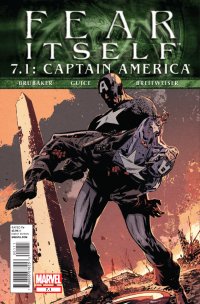 Fear Itself 7.1: Captain America
Fear Itself 7.1: Captain America
by Graig Kent
I can’t say for certain, but I think Fear Itself, Marvel’s latest sprawling Event (9 tie-in mini-series, 6 tie-in one-shots, and a plethora of ongoing series tie-ins) kind of got lost/utterly buried under the weight of DC’s New 52. Even before reviews of the relaunch dominated blogs and review columns (such as ours), Fear Itself had to contend with a flurry of speculation and outrage at DC’s audacious ploy. Let’s put it this way, I’m a monthly reader of Captain America and I was unaware for months that Captain America (Bucky Barnes) had been killed during the event. As well, I wasn’t aware that Thor had also succumbed to lifelessness until I read the preamble in this milking-it-for-all-its-worth 7.1 issue of Fear Itself.
Let’s put it this way, the death of Johnny Storm, the Human Torch, barely a year ago, made it to mainstream news sources internationally, and he didn’t just have a blockbuster movie out the preceding summer like Captain America and Thor both did this year. I didn’t see a single mention of these big events in Captain America, or Thor’s life in the mainstream (and frankly it wasn’t very well publicized in the industry web rags either).
Now, from what I hear, Thor has been replaced, past and present, while the reports of Bucky’s death, as is revealed this issue, were greatly exaggerated (and it appears Johnny’s back soon, too). Is Bucky’s the quickest death-to-resurrection ever? No, but ridiculously close, and, for some I’m sure, an unwelcome deceit. It was a deceit meant for shock value, to make the Event exciting but without upsetting the character’s fan base long term, and hell, pulling a new series for the character out of it all.
One can be bitter, one can be jaded, but one also needs to realize that in a lagging industry, It’s all done in the name of selling comics. And if the comics are good, then it’s easier to forgive isn’t it?
But is Fear Itself 7.1 actually any good?
Ed Brubaker has been the main man on Captain America for a half dozen years, an incredibly impressive and entertaining run on the character and his legacy, even more impressively building Bucky Barnes into one of the most intriguing characters in comics. With all the work Brubaker’s done with him, I found it hard to believe that he would just let Bucky be sacrificed, and that hunch proved accurate.
Via Steve Rogers, Brubaker acknowledges the deceit of Bucky’s “death” perpetrated on the fans, and attempts to sympathize with the readers by having Steve beat the living snot out of Nick Fury for his role in the ruse. The in-story reasoning for the deception is rationalized well (thus leading nicely to a new Winter Soldier series), and the book wisely side-steps yet another melodramatic character memorial, but it’s still largely 22 pages of back-pedaling.
Butch Guice illustrates all the particulars with an even more dramatic, shadow-heavy gusto that usual, lending plenty of weight to the proceedings. Enter colorist Bettie Breitweiser who softens things with a toned-down palette, giving Guice’s art a pulpy, retro feel. Guice has worked on and off the main Captain America series with Brubaker for the past few years and their intimacy with the characters is tangible and the saving grace for what would be an otherwise aggravating contrivance.
It’s not an outright successful fake-death/rebirth, but at least it wasn’t milked for too long.
Rating: 




Out of a Possible 5 Stars
Darkwing Duck #18 and Ducktales #6 (Boom!, $2.99)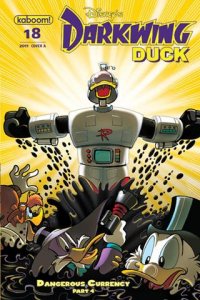
By Adam Prosser
When people talk about superhero comics existing in their own, strange, sometimes incomprehensible paradigm—with decades of continuity, crossovers stretching across multiple books, and odd pacing (either hypercompressed or decompressed)—it’s sometimes shrugged off as being part of the nature of the medium. And indeed, the need to cram 22 (or whatever) pages with story in a book that costs 3 bucks or more and comes out once a month plays a major role in shaping these stories. But there’s no getting around the fact that even other genres of comics rarely employ the same kind of storytelling techniques as superhero comics. I’ve often felt that the level of narrative sophistication that Stan Lee, Jack Kirby and the rest of the Marvel Bullpen are credited with providing to comics tends to overlook the efforts of people like Will Eisner, Jack Cole, and Carl Barks, all of whom were writing and drawing hilarious, moving, elegant stories with well-rounded characters years before the Marvel Bullpen came together, stories that are still in many ways more accessible than the classic Marvel efforts. Superheroes have always been a bit of a breed apart, narratively.
I don’t mean that as an insult, mind you—superheroes were also the breeding ground for a lot of interesting experimentation, which is part of what’s made them a bit of a niche genre—but it really is striking how different the method by which you “read” superheroes, versus your old-school funny animal comics. I bring this up because the contrast is highlighted rather strongly in Boom!’s Disney comics, which have been adapting Carl Barks characters (and characters who are clearly descended from Barks’) in a way that’s more in keeping with what we’d think of as the superhero style. The fact that at least one of the characters, Darkwing Duck, is an actual superhero muddies the waters somewhat, but these characters existed in a different paradigm before these comics were published.
The aforementioned Barks, along with his predecessor Floyd Gottfredson, adapted the Disney characters for comics, along the way transforming them from Looney Tunes-style cartoon vaudevillians into full-bore adventure heroes (while not forgetting their humorous roots). With his creation of Uncle Scrooge, Barks had a character who could just as easily be the source for simple gags about stinginess or a source of trouble for Donald and his nephews as he could a globe-trotting adventurer and inspiration for dozens of later heroes. The animation division finally caught up with Barks in the 90s, launching the Ducktales cartoon, inspired by Barks’ Uncle Scrooge adventures and providing the bedrock for a string of fondly-remembered cartoon shows that maintained the same balance of cartoon mayhem and adventure. One of these characters was the superheroic Darkwing Duck, who (along with the later and more serious Gargoyles) may have been partly intended as Disney’s response to the then-contemporaneous Batman: The Animated Series. The result of all this was an odd but exciting (especially if you were an 8-year-old kid) mashup of comedy and adventure that did a lot to help bring Disney’s properties into the present.
Last year, Boom brought the whole process full circle by launching a Darkwing Duck comic, promptly followed by a number of other Disney series including, yes, Ducktales. What’s interesting, though, is that the two series have moved even closer to superhero storytelling in the process, especially Darkwing; like the various Marvel and DC superheroes, these are titles with an obvious appeal to kids, but will arguably have a strong appeal to a contingent of nostalgic fans. And writers Ian Brill (Darkwing) and Warren Spector (Ducktales) have certainly exploited this. The Darkwing Duck series began with a new status quo for Darkwing Duck that had him working as a cubicle drone in a city that had been pacified by a huge, evil corporation called Quackwerks, and which in many ways owed a strong debt to Watchmen; DuckTales spent its first 4 issues telling a story about Scrooge attempting to return many of his beloved treasures to their rightful owners, with dozens of easter eggs and even plot points aimed squarely at old-school Scrooge fans. These were not the works of writers trying to appeal to a new generation (not solely, anyway); it was the work of geeky fanboys for these particular properties, riffing on their knowledge of continuity and trying to riff on some pretty hardcore minutiae.
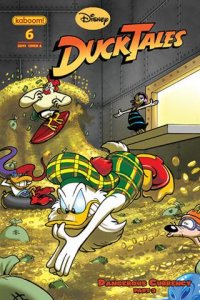 Things have gotten even more geeky and insular with these latest issues, which represent the culmination of a big Ducktales/Darkwing crossover involving most of the Disneyverse villains (The Phantom Blot, Magica DeSpell, the Beagle Boys, and most of Darkwing’s rogue’s gallery) taking over the city with some kind of evil ink that transforms everything it touches. It’s also got the return of Gizmoduck, a cyborg superhero who was introduced on the old Ducktales cartoon but only ever featured in a couple of episodes, and the fallout from an earlier Darkwing story about parallel dimensions. It’s a plot that’s hard to follow if you haven’t been reading either comic (or Darkwing’s, at least) up to this point, and whatever pretense the writing teams may have had at ensnaring new readers is pretty much out the window. Heck, I went back and read the entire series of both of these comics, and I was still frequently confused by the plots playing out here.
Things have gotten even more geeky and insular with these latest issues, which represent the culmination of a big Ducktales/Darkwing crossover involving most of the Disneyverse villains (The Phantom Blot, Magica DeSpell, the Beagle Boys, and most of Darkwing’s rogue’s gallery) taking over the city with some kind of evil ink that transforms everything it touches. It’s also got the return of Gizmoduck, a cyborg superhero who was introduced on the old Ducktales cartoon but only ever featured in a couple of episodes, and the fallout from an earlier Darkwing story about parallel dimensions. It’s a plot that’s hard to follow if you haven’t been reading either comic (or Darkwing’s, at least) up to this point, and whatever pretense the writing teams may have had at ensnaring new readers is pretty much out the window. Heck, I went back and read the entire series of both of these comics, and I was still frequently confused by the plots playing out here.
Again, though, I don’t want to make this sound like a total condemnation. The characters, and the books they star in, are still fun, and as I’ve argued in the past, kids aren’t always turned off by heavy-duty continuity. Besides, no matter how much Brill and Spector geek out over this stuff, we’re still talking about cartoons that aired for a couple of years and didn’t really have that much “continuity” to begin with, so it’s probably not too hard to follow if you start at the beginning of the storyline. Still, I feel like this crossover suffers from much of the same problems that your average superhero “event” does, with a dense, shifting plot featuring incident after incident at the expense of character work and coherency (and, in this case, jokes). Whatever virtues these two books had (I’d give props to Brill, who’s legitimately funny and can craft an exciting superhero story, over Spector, whose comics are oddly paced and somewhat lacking in charm) they’re muddied rather than enhanced by joining forces.
This is the last hurrah of Boom’s Disney comics, anyway, presumably because Disney’s acquisition of Marvel means they can print their own comics there rather than licensing them out to an outside company like Boom. So I guess the feeling was that it all had to end with a bang. Still, I think this was a misstep for a “good” all-ages series and a “decent” one, respectively. I’ll be interested to see if Brill, in particular, makes the jump to Marvel, and what happens to these characters in the future. I do recommend picking up some of the Darkwing Duck trades (and, while I’m at it, the classic Carl Barks reprints!) but this is definitely not the place to start.
BOTH: Rating: 




Out of a Possible 5 Stars
Marvel Point One one-shot (Marvel, $5.99 or thereabouts)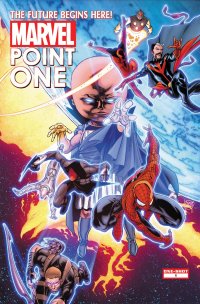
By Jeb D.
In light of the serious bollocking that Marvel has taken from DC in market share terms over the past couple of months, this is a curiously muted “teaser” for what’s coming from the Mouse House of Ideas in 2012. Just for starters, this is 50-odd pages of Marvel comics during which Wolverine appears in exactly two panels. And when you consider that the Avengers film will be Marvel’s biggest priority of any kind for next year, the book is awfully light on those big guns, as well. So, on the one hand, you could say that it’s a shrug-worthy collection of stories featuring characters you don’t care about. On t’other hand, it’s a major Marvel undertaking that doesn’t simply trot out the usual cast of franchise players, and isn’t that what we’re always asking for?
As with most anthologies, the quality varies from story to story, and the diverse cast of characters means that most readers’ level of interest will have the same ebb and flow. But to take them a section at a time:
Framing Sequence: Behold The Watcher. Ed Brubaker and Javier Pulido, colors by Javier Rodriguez. While it seems a cheesy bit of retcon, the idea that Watchers have to periodically “shut down and reboot”, so to speak, is reasonably logical, and Brubaker puts it to good use as some nasty space-explorer infiltrators take that opportunity to harvest intelligence about what’s happening to various Marvel characters throughout various worlds and timelines. Their ultimate intentions are revealed at the end, and it’s a nice way of introducing the rest of the volume. Pulido’s art is a wonderful mashup of early-60’s Kirby and Ditko, with the use of huge white gutters and borders a particularly nice touch.
Nova: Harbinger. Jeph Loeb, Ed McGuiness, and Dexter Vines, colors by Morry Hollowell. When you hear industry pros speak of their personal regard and affection for Loeb, it can be easy to forget just why so many serious comic fans detest the guy’s work. Here’s a little reminder: Nova (who, in this incarnation, may or may not be Richard Rider) tries to warn our old pal Terrax that total cosmic devastation is at hand by telling him that it’s so bad that it would “make Galactus fudge his pants.” Uh huh. Well, Terrax ain’t buying, and after they exchange some pointless throwdown, Nova splits, Terrax and his entire world get creamed. Nova’s response to the tragedy as he makes his escape: “All those people… Epic fail.” Nice one there, Jeph.
Age Of Apocalypse: The Myth Of Man. David Lapham, and Roberto De La Torre, colors by Lee Loughridge. I’m not the biggest fan of giant X events, and I honestly don’t recall reading much of the original Apocalypse stuff. But Lapham imagines an intriguing future reality with a small group of costumed humans (with such familiar family names as Trask, Creed, and Stryker) standing as the last resistance to the (evidently) benevolent despotism of Weapon X. It’s a very well-executed vignette, that never feels heavier on exposition than on characterization, and De La Torre captures its dark tone perfectly. This cast of “X-Bolts’ (I just made that up, thank you very much) wouldn’t normally catch my interest, but I will certainly give the new series a look to see if Lapham keeps up this pace.
Scarlet Spider: The Scarlet Thread. Chris Yost, Ryan Stegman, and Michael Babinski, colors by Marte Gracia. The Clone Saga came during one of those periods where I wasn’t reading much in the way of superhero comics. So on the one hand, I don’t have the visceral distaste for it that so many fans do; on the other hand, I have no particular emotional attachment to any of its characters. But the recent Spider-Island was a nice bit of event storytelling, so I’m at least sort of interested in what the future might hold for Kaine. Chris Yost gives good POV in Kaine’s narration, and the slightly cartoony art from Stegman and Babinski is vibrant and well-characterized; they’d be a fine regular team on any of the various Spidey-related books.
Coldmoon & Dragonfire: Yin & Yang. Fred Van Lente and Salvador Larroca, colors by Guru-EFX. An origin story for a pair of new sibling super-characters, and thanks to Larroca, there’s rather a “Morrison New X-Men” vibe. It sets up a big bad that will likely play a role in 2012, and while I don’t know that we’ve exactly got a shortage of teen heroes at this point, it’s well-done for what it is.
Doctor Strange: The Shaman of Greenwich Village. Matt Fraction, Terry and Rachel Dodson, colors by Sonia Oback. Everyone always wants a Dr Strange series, but when they happen, everyone doesn’t buy them. So Fraction’s latest attempt to keep the good Doc busy will be a new Defenders series. This homey little yarn, with Strange in snappy business suit and fedora rather than mystic robes, has a nice sense of place, and Strange’s journey into the dream of a writer who’s more than he appears to be shows him visions of an endangered reality as well as a quick glimpse of his new teammates. The usual excellent art from the Dodsons (particularly given the almost complete lack of shapely female characters they have to work with).
The Avengers: Age of Ultron. Brian Micheal Bendis, Bryan Hitch and Paul Neary, colors by Paul Mounts. OK, let me see if I have this right: something resembling World War Three was unleashed when The Owl didn’t pay sufficient protection money to Ultron? Eh, whatever. This is seven pages of widescreen Hitchy goodness (with perhaps a bit more Photoshop blur than was called for), and will likely play out one way or another in one of the umpteen Bendis Avengers books that you’re not reading anyway.
All in all, a more or less pointless exercise (it’s not like all the information here won’t be recapped when the various series launch/resume next year), but one that is mostly handled well. I understand that some retailers are discounting this pretty heavily (Marvel “gifted” many retailers with tons of additional free copies), so while I wouldn’t recommend it at six bucks, for something less than that, you could do worse.
Rating: 




Out of a Possible 5 Stars